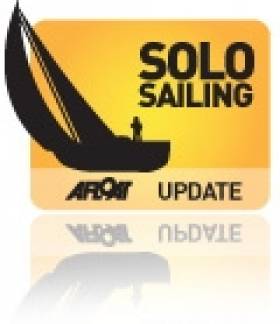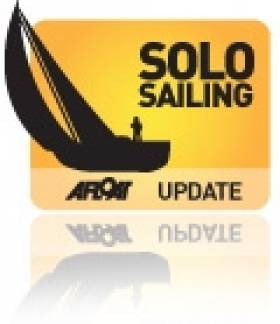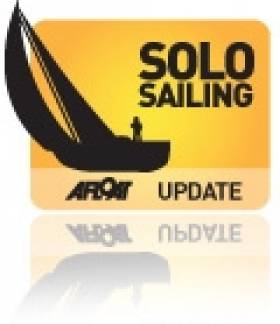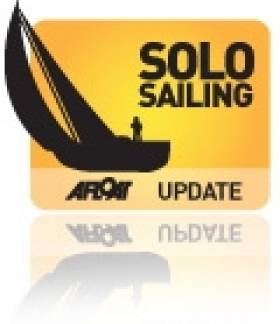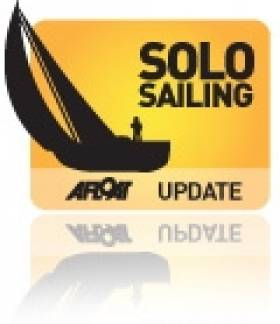Displaying items by tag: solo sailing
French Solo Sailor Aims For Atlantic RIB Record
#Solo - French sailor Christophe Maupaté aims to follow in the wake of Ireland's own Enda O'Coineen in his attempt to be the first person to cross the Atlantic solo from Bordeaux to New York by RIB.
The Figaro veteran will set off on 16 July 2016 from Bordeaux heading north, via the Celtic and Irish Seas – including a stop-over in Dun Laoghaire – on an epic voyage that will see him trace a semi-circle around the North Atlantic.
That route takes Maupaté via the Orkneys, Iceland and the southern tip of Greenland to Canada's Maritimes provinces and onward to New York to coincide with a commemorative voyage by a replica of historic French general Lafayette's ship Hermione.
And he'll be doing it all single-handedly in a 7.5m RIB, a custom French-built Zeppelin, equipped with a Suzuki four-stroke outboard motor and Garmin navigation and communication devices.
The Atlantic has been crossed by RIB several times before, most notably by TV adventurer Bear Grylls and team in 2003 from Canada to Scotland, and more recently by the Brown brothers from Florida to London in 2009.
But the closest anyone's come to a solo RIB crossing was Enda O'Coineen, when he helmed the 5.5m Zodiac RIB Kilcullen III from Halifax in Nova Scotia to Dunmore East in the mid 1980s – a voyage recounted in his book The Unsinkable Kilcullen.
There is no Guinness World Record for O'Coineen's feat, so Maupaté aims to be the first into the books with his own incredible expedition of some 4,460 nautical miles.
More details can be found on the official Bordeaux -> New York in Solitare website HERE.
New Solo Fastnet Offshore Race Added to the 2016 Calendar
As Howth’s Conor Fogerty closes out the final few miles of the ARC Transatlantic Rally at the helm of his Jeanneau Sun Fast 3600 Bam, we can reveal the former Clipper skipper is among 46 single-handed sailors listed as provisional entries for the first soloFASTNET next July. The Solo Offshore Racing Club (SORC) have announced the soloFASTNET, a brand new offshore race on one of the world's most demanding ocean race courses. Starting off Cowes on July 2, 2016, the fleet will navigate the 610NM course west along the English south coast, across the Celtic Sea to the Fastnet Rock off Ireland, south around the Scilly Isles and to the finish off Plymouth.
The soloFASTNET is a handicap race under IRC with the option, subject to interest, to include one design classes. The Solo Offshore Racing Club prides itself on an ethos of safety and good seamanship. All boats must meet ISAF Category 2 Regulations, AIS ClassB and Personal Locator Beacons (PLB) and YB trackers are mandatory and all competing skippers will be required to have substantial short handed offshore experience.
In less than a month from the soft launch of the website provisional race entrants already total an outstanding 46 yachts. A broad range of skipper nationalities sporting a wealth of shorthanded experience have registered, including Australia, UK, France, Belgium and Ireland. The latest list of interested boats and skippers can be viewed on the website.
The soloFASTNET has been certified by the Royal Western Yacht Club of England (RWYC) as an official qualifier for their 2017 OSTAR race. The RWYC will host the soloFASTNET prize giving and post-race party in their clubhouse.
More information here
Kinsale Welcomes Solo Sailors In Celtic Sea Challenge
#SoloSailing - The first leg of the Solo Offshore Racing Club's 2014 Celtic Sea Challenge is already under way, with the fleet of 18 confirmed entries making their way to Kinsale from Falmouth.
The programme continues tomorrow (Friday 25 July) with the soloists heading to Islander's Rest on Sherkin Island via the Old Head of Kinsale, while on Saturday (26 July) the fleet will progress to Lawrence Cove on Bere Island.
Thereafter the route goes in to Dingle before next Tuesday's big push back to Plymouth via Bishop Rock.
Despite the easy weather Ireland's been basking in these past few days, the Celtic Sea Challenge is indeed a challenge only for experienced solo sailors.
In the far west of Kerry especially there are few places to stop for fuel and food, so only the best prepared will make the grade.
Francis Joyon began his attempt to smash the outright solo sailing record this morning at 09:15:20 hrs UTC (11:15:20hrs CET). In order to beat the current record of 5 days, 19 hours, 30 minutes and 40 seconds held since July 2008 by Thomas Coville on his trimaran Sodebo, Francis Joyon and his maxi-trimaran IDEC will have to cross the latitude of The Lizard by 0445hrs UTC (0645hrs CET) on Monday 17th June.
Living up to the legend...
The final 24 hours in New York were very stressful for the Breton sailor from Locmariaquer, as everything was a bit of a rush. He had to find a RIB to help him out of Gateway Marina, finish stowing supplies aboard, work on the final weather details... and once again, as we have come to expect, Francis Joyon in his usual style, took care of everything himself, while benefiting whenever possible from any kind offers of help from other seafarers on the pontoons. Once out of the bay off New York, the "big red bird", IDEC was free to fly in the open waters of the Atlantic. The SW'ly wind was blowing as forecast off Ambrose Light, and in spite of a heavy swell, Francis Joyon was able to speed off from the outset at record pace with the speedo stuck above 23 knots. "The swell was hitting us as we left Ambrose Light," Francis Joyon explained at lunchtime today. He was happy to be alone again at sea and relieved to have made it out of the Hudson and away from the shoreline without hitch, in spite of a few anxious moments. His final hours in the Big Apple were rather rushed. "I didn't have time to take care of all the supplies. I asked a guy on the pontoon to help me. He was Russian; he gave me some food from home. So it looks like it's going to be Russian food this week..."
It was during the night that Francis got his boat away alone and removed the propeller, in order to head for the precise location, where we used to see the famous Ambrose Light. One last look around, the autopilot was switched on and the genoa trimmed... and Francis Joyon told the official from the World Speed Sailing Record Council, who was in New York, to start the clock for the big red trimaran. At 09:15:20 UTC (1115hrs CET), IDEC was off on her latest battle with the Atlantic.
A 50-50 chance
"The weather opportunity isn't brilliant, but we will have to make do with that..." Sounding light-hearted, once the decision had been taken in close collaboration with Jean-Yves Bernot, his accomplice on many a maritime adventure, Francis Joyon only wanted to look ahead to the next few hours. "I know that I should be getting some good conditions for the first two-thirds of the course, and according to the latest weather models there is some doubt about the finish, if we follow the route taken by the low-pressure area," explained Francis. "The route won't exactly be the Great Circle route, as I shall be sailing a little further south. But on the other hand that means I shall be avoiding the worst fogs around the Great Banks..." Fog, which has already engulfed IDEC in her first few miles of racing, forcing Francis Joyon to keep a close eye on the radar and over the bow of the boat. "I have just sailed between two whales.That was nice. They left me enough room to get through without having to manoeuvre..." A 30-knot SW'ly wind is forecast ahead of the maxi-trimaran IDEC, with seas that are going to become increasingly tricky; Francis Joyon is facing a mammoth task and that is without taking into account the lack of sleep after a tiring voyage and a more or less sleepless night in New York. "It's when I'm at sea that I get my rest," Francis reassured us...
Mini Transat 2013 Qualifications Announced
#minitransat – The Open Demi-Clé (double handed) and Pornichet Select (single handed) open the batting for this season's racing for the Atlantic Ministes, whilst in the Mediterranean competitors are offered the four races of the Mini-Golfe au Gran Premio d'Italia. With 112 pre-registered for 84 available starting slots, the battle for places will be fierce.
On the Mediterranean the ball began to roll with the Mini Golfe 2013, which saw twenty competitors come together in La Grande Motte in March to begin their battle. The rest of the program in the Mediterranean will be focused on the Italian races with between 15 and 20 competitors, including the American Jeffrey Mac Farlane (www.jeffreymacfarlane.com) who steps aboard Henry-Paul Schipman's old boat which finished 3rd in the Transat 6.50 in 2009.
In the Atlantic, the Open Demi-Clé saw adverse weather conditions force a postponement for the race between Locmiquélic and Pornichet. In the prototypes Gwénolé Gahinet (Watever-Nautipark) sailing with Gregory Mouly eventually got the upper hand after long struggle against Giancarlo Pedote (Prysmian) and Sébastien Josse. A week later the two sailors, this time sailing alone, finished in the same order in the Pornichet Select. Gwénolé and Giancarlo have already staked their claims as podium contenders for the next Mini-Transat, alongside other regularly placed competitors such as Benoit Marie (benoitmarie.com), Louis Segré (Roll My Chicken) and Bertrand Delesne (TeamWork).
Series: Justine hits her rhythm
For the series production boats, the winning move was credited to Justine Mettraux (TeamWork) who crushed the competition in the Pornichet Select. This Swiss sailor showed she has a good head on her shoulders by refusing to engage, unlike the rest of the pack, in the currents off Belle Isle, giving it a wide berth instead. The result was a lead of several hours, which reinforces the standing of this sailor who, after her victory in 2012 in the first leg of the race Les Sables – Azores, confirms that she has both good speed and that her navigation and tactics are particularly sharp. She nevertheless faces some very stiff competition in which you can already include names such as Renaud Mary (www.runo.fr), Clement Bouyssou (No War), Ian Lipinski (Pas de futur sans numérique), Aymeric Belloir (Tout le monde chante contre le cancer) and also Elise Bakhoum (Quéramix). This mix demonstrates brilliantly that in the Mini class equality between men and women is not just a beautiful ideal.
During the month of May the Ministes will cross the English Channel on the occasion of the La Trinité –Plymouth followed by the UK Fastnet, before returning to Douarnenez for the Trophée Marie-Agnès Péron from 10 to 15 June, which, with 91 registered, has a full entry. On 17 June, the fleet will head out once again from Douarnenez for the Mini-Fastnet, racing around the legendary lighthouse at the southwestern tip of Ireland. In summary, for the Breton city, these will be the first stirrings before the long-awaited October 13, 2013 deadline.
The course 2013 : back to the origins
First leg Douarnenez – Arrecife (Lanzarote island) : 1200 NM.
Second leg Arrecife – Pointe à Pitre : 2800 NM.
The dates
Prologue October 6th 2013.
Start from Douarnenez Octobre 13th 2013 at 1.00 PM.
Arrival in the Canary islands between October 23rd and 26th 2013.
Start from hte Canary Islands November 9th 2013.
Arrival in Guadeloupe between November 23rd and 30th 2013.
New Solo Challenge Across The Celtic Sea
#Solo - Elaine Bunting writes on her Yachting World blog about this summer's Jester Baltimore Challenge, a spin-off of the solo transatlantic Jester Challenge for small boats.
The new event is much smaller in scale, with a route across the Celtic Sea from Plymouth (or Pwllheli in Wales) to Baltimore in West Cork starting on Sunday 16 June.
But that's intended with low cost of entry in mind - there are no fees to pay - to attract small boat sailors who've yet to test themselves in a solo challenge.
Yachting World has more on the story HERE.
Vendee Globe Front Runner Collides with Metal Object
#vg12 – At 0700hrs this morning, a front runner in the Vendee Globe race Vincent Riou (PRB) warned his shore team that he had collided with a floating object.
The skipper, who was at his navigation station at the time was able to get on the deck immediately after the impact and see that the object that had struck PRB was a large metal buo).
Following the collision, Riou found that the hull of his boat was torn and delaminated for about one metre.
The impact was on the starboard side of the boat and the torn area is three meters from the bow.
Riou was not injured in the collision. He will wait until daybreak to assess the damage and the possibility of repair.
Conditions in the area are good and the wind between 12 and 15 knots.
At the moment of impact, Riou immediately called the race office in order to report the position of the buoy to other competitors.
Riou, the winner of the 2004-05 Vendée Globe, rescuing hero of the 2008-09 edition and one of the favourites for this race has suffered a serious blow in the south Atlantic. A statement from his team said that Riou was uninjured after he had collided with a metal buoy but that the impact had damaged the bow of PRB:
"At 0700hrs (French time) on Saturday morning, Vincent Riou (PRB) warned his shore team that he had collided with a floating object. The skipper was at his navigation station at the time was able to get on the deck immediately after the impact and see that the object that had struck PRB was a harbour buoy (a large metal buoy).
"Following the collision, Riou found that the hull of his boat was torn and delaminated for about one metre. The impact was on the starboard side of the boat and the torn area is three metres from the bow. Riou was not injured in the collision. He will wait until daybreak to assess the damage and the possibility of repair. Conditions in the area are good and the wind between 12 and 15 knots. At the moment of impact, Riou immediately called the race office in order to report the position of the buoy to other competitors."
Riou is about 550 miles east of the north coast of Brazil and 450 miles due north of the Trindade Islands. He was in third place at the 0500hrs (French time) rankings, just 69.1 miles behind the leader Armel Le Cléac'h, (Banque Populaire), having been in the lead group since they started from Les Sables d'Olonne two weeks ago. It was an otherwise quiet night for the fleet with no change in the rankings in the morning.
The 40-year-old Brittany skipper is famous for his skill and inscrutability but you need some luck to finish a Vendée Globe let alone win one. It these hidden dangers, rogue containers and buoys that are not where they are supposed to be, are what the skippers fear most. Speaking before the start Riou said that sonar was not a practical solution:
"We did some research with an institute in France on a sonar system but it is not practical because it is half the weight of the whole boat and it uses lots of power," he said. "It needs a lot of energy and the boat is very fast and so to use a sonar to predict 200m ahead of the boat when you are travelling at 20 knots you need a very powerful system and it's impossible to find one that is not too heavy. You have to be realistic these kind of devices are so impractical we are not going to install them and so we can't even consider them. It's too heavy and it's uses too much power."
Riou has faced greater dangers than this in the Vendée Globe. In the 2008-09 edition his older rival, Jean Le Cam, lost his keel bulb and capsized 200 miles west of Cape Horn and it was Riou who turned and reached him first as fears for Le Cam's life grew. Le Cam had spent 18 hours trapped and brave five-degree water and 12 foot waves to swim to Riou, who got as close to Le Cam's boat as he dared. In the process Riou is thought to have clipped his outrigger on Le Cam's upturned keel and just 36 hours later, having continued the race with Le Cam on board, Riou was dismasted after just rounding Cape Horn. He was later awarded joint third place by the organisers.
Riou's PRB is a new VPLP-Verdier-designed boat, one of four who are dominating this race and which before his collision were in the top four top positions in the fleet. The four boats are all lighter and faster than previous generations, with PRB's thought to be the lightest at 7.5 tonnes.
More than anyone Riou will know that any repairs must be secure enough to withstand what the fleet faces as they prepare to drop down into the Roaring Forties and the mountainous seas of the Southern Ocean.
SORC Success for 'Dinah'
The annual Solo Offshore Racing Club's 'Channel Week' was held last week in a varying mix of conditions. Seven offshore legs over eight days took the fleet from the Solent to the Channel Islands, and on to three French ports, before crossing back to the Weymouth and finishing in the Solent. Conditions were challenging throughout the event, including everything from a 100m beat to Guernsey in 25+knts and spring tides, to a light airs run from Weymouth to the Solent on the final day.
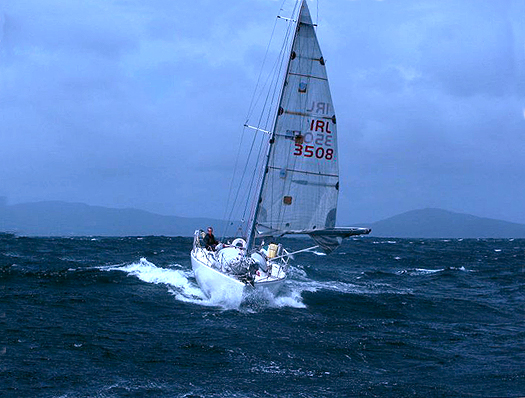
The much travelled 'Dinah' owned and skippered by Barry Hurley from the Royal Irish Yacht Club put in a strong performance over the whole week, scoring no lower than 2nd in class in every race. Consistency proved key in the no discard series, with Hurley eventually finishing 1st in class and 3rd overall. Hurley commented, "It was a fantastic event, with long legs in difficult conditions, leading to very short stopovers to recover and carry out routine maintenance. Boat preparation was key with several entries suffering breakages along the way. In the end I needed a win on the last day to guarantee a win in class overall and I got a great start before making the most of the positive tide by gybing several times under full mainsail and symmetric spinnaker. My main rival chose the shorter straight line route, but thankfully the option of longer distance in more tide paid off in the end. I'm delighted with the result."
In a few weeks time on August 14th Barry will be joined again by his usual crew Andy Boyle, also of the Royal Irish Yacht Club, as they set off on the Rolex Fastnet Race double handed against a fleet of over 350 boats.
First UK Offshore Sailing Academy Squad Selected
From an original list of over 50 applicants, those who made it to the shortlist were put through a grueling mental and physical selection process. They were pushed well beyond their comfort zones with nine ultimately chosen to be part of the Development Squad:
• Oliver Bond (30, Southampton)
• Nick Cherry (25, Birmingham/Southampton)
• Sam Goodchild (20, Southampton)
• Simon Hiscocks (37, Surrey/Portland)
• Nick Houchin (26, Tadley, Hampshire)
• Nigel King (41, Lymington)
• Becky Scott (24, Scotland/Fleet)
• Phil Sharp (29, Jersey)
• Oliver Young (22, Saltash)
As part of the Squad, they will begin a winter-long programme where they will develop the skills needed to perform as a world class offshore sailor. The Academy will be based from the Weymouth and Portland National Sailing Academy until the end of November when they will relocate to La Grande Motte Figaro School (CEM). From here CEM Director Franck Citeau will manage a full programme for the sailors through to the end of March. At that point one of the Squad will be selected for the scholarship which will enable them to race in the 2011 French Figaro circuit in one of the Artemis Figaro boats. The remaining Squad will continue to train and take part in a series of races throughout 2011, including Royal Ocean Racing Club's most famous race the Rolex Fastnet Race, and the Tour du Bretagne at the end of September.
The group will be bolstered by two associate members, 36 year old Pip Hare (Felixstowe) and 37 year old Conrad Humphreys (Plymouth) who, instead of being provided with equipment and costs, will bring their own campaign to train with the Academy. As the project develops, the aim is that more people will move on from the Development Squad to become associate members and keep training with the Academy.
Sailors will remain in the Development Squad for as long as they are attaining pre-agreed training goals. The aim is to allow sailors the time in the Figaro boats to develop their skills before moving into other classes or finding their own funding for a campaign. Further selections to top up the squad will be held in April and September 2011.
Conrad Humphreys commented: "When the Artemis Offshore Academy was announced earlier this year, I immediately thought it was not only a great idea but also the missing link for UK aspiring and seasoned solo sailors. No one would argue that when compared to our French counterparts, we simply do not do enough collaborative training or development in between the major events. The Figaro championship is one of the best programmes for short-handed development and there is no secret to the fact that every Vendée Globe winner maintains close links with the class. I hope the Artemis Offshore Academy will become a place to nurture new talent and provide Associate sailors like myself with support to compete at the top level. I will be looking for a sponsor to do the Solitaire du Figaro in 2011 and the Transat in 2012 and I look forward to working with the rest of the squad over the coming 12 months."
Simon Hiscocks commented: "The British success in the Olympics is a direct result of a very long programme that the RYA has run right from the grass roots getting people learning to sail up to winning Olympic gold medals. And that whole thing has a massive structure behind it - you name it they are on it. Hopefully we can transfer that success into this field through this programme. The Artemis Offshore Academy opens up a whole new world of opportunities, not least of which is potentially being able to do the Vendée Globe, and I am really excited to be part of it."
John Thorn, Artemis Offshore Academy Performance Director commented:
"From their application and CVs, we knew we had the sailors. It was then more a question of trying to identify some of the other traits that we felt were an important part of success in short sailing and offshore sailing. There were lots of elements that we were looking for.
The nine development squad members that we have chosen have got tremendous potential – and we looked at that potential over short, medium and long term. But they are experienced sailors, they are technical competent sailors and they have the desire to win.
We will identify what the sailors need and we will deliver that, using the best coaches, the best venues, the best resources we can. We'll give them everything they need in order to be successful.
I am tremendously optimistic and truly believe, because we are building a foundation for long term success, that we will see an Artemis Offshore Academy sailor on the podium for the Vendée Globe. It is an incredibly exciting time and this is just the beginning."
Steve White announces bid to break the 'Westabout' Solo Circumnavigation Sailing World Record
Professional sailor Steve White has announced his intention to break the current world record for circumnavigating the globe single-handed, non-stop the "wrong way", against the prevailing winds and currents. Steve will be sailing a Volvo Open 70, which would usually be crewed by ten people. Taking place this winter, the attempt will mark the 40th anniversary of the original record set by Sir Chay Blyth (CBE BEM) on 'British Steel', who embarked on the epic journey described by The Times in 1970 as the 'Impossible Voyage'. The current record for completing the 22,000 mile course is 122 days, 14 hours and 4 minutes, and is held by Frenchman Jean Luc Van Den Heede.
Steve White says, "After the amazing experience of the 2008 Vendée Globe, it seemed like the right time to focus my attention on this record that I have been thinking about for a long time, and which fits in nicely before the next Vendée Globe in 2012. The record is acknowledged as probably the hardest and certainly the most gruelling record in sailing, and I am under no illusions about the enormity of the task in hand, both of sailing upwind and against the current in the Southern Ocean, and about the power and size of the boat we have chosen. Jean-Luc Van Den Heede is a legend and his record will be tough to beat, but I think it is achievable"
Sir Chay Blyth CBE, BEM commented, "It's wonderful that Steve is planning to attempt what many regard as the ultimate sailing challenge. Hundreds have completed the voyage following the classic Eastabout route but doing this in reverse is a quantum leap removed, which is why only 5 people including Mike Golding and Dee Caffari have tried it. It takes a special character to tackle the trip and Steve is an extremely experienced yachtsman who I believe has the right skills, tenacity and determination to set a new World record." When asked if he would be tempted back to re-trace his footsteps Chay said, "Not a hope in hell."
The team at White Ocean Racing are currently looking for potential sponsorship partners who are interested in aligning themselves with such an outstanding example of human endeavour, which will attract massive UK and international media interest, and capture the imagination of people from all walks of life around the globe. The rewards of title sponsorship are exceedingly high, as this is a unique and steerable opportunity.
Steve added, "I have long pondered this record since reading both Chay's and Mike Golding's books on their respective attempts. With a very successful Vendée Globe behind me, and a team with a wealth of experience now in place, I am confident I can do this record justice. I really am more excited about this than I have been about anything else, and I am very much looking forward to crossing the start line. I will leave between October and December this year, depending on the arrival of a suitable weather window, and how soon we attract a sponsor".
For further information visit: www.whiteoceanracing.com



























